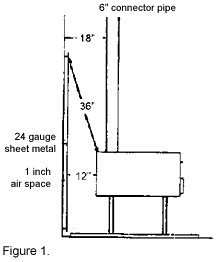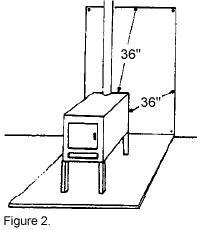WHAT SHOULD I PLACE
A STOVE ON?
For
heaters set on legs or pedestals that provide not less than
6 inches of ventilated space beneath the fire chamber or base
of the appliance, use closely spaced solid masonry bricks or
blocks not less than 2 inches thick. The top surface of the
bricks should be covered with sheet metal not less than 24-gauge.
The
floor protection should extend not less than 18 inches beyond
the appliance on all sides. A floor protector listed by a
recognized testing laboratory such as UL may be used if installed
in accordance with the installation instructions.

HOW FAR SHOULD
A WOOD STOVE BE FROM AN UNPROTECTED WALL OR
COMBUSTIBLE
MATERIAL?The standard clearance for appliances installed in
rooms which are large in comparison to the size of the appliance
is 36 inches from the top, sizes, back or front of the appliance.
Otherwise, install according to the manufacturer's instructions.
IS A MASONRY VENEER
COVERED WALL CONSIDERED SAFE FOR REDUCED CLEARANCE?
No!
National Fire Protection Association (NFPA) codes permit reduced
clearances to combustible walls if adequate protection is provided.
Sheetrock, sheet metal, masonry veneer and other thin or non-insulating
materials placed directly against walls give little protection.
These materials conduct heat very well; they will be almost
as hot on their back sides as they are on their exposed sides.
Reduced
clearances are acceptable for the following:
- an
engineered protection system approved by the inspecting
authority having jurisdiction
- products
and materials listed for protection purposes
- a
non-combustible protector mounted an inch or more away from
a combustible wall to allow free circulation of air behind
it
The
reduction is specified by NFPA and most codes. For example,
when required clearance with no protection is 36 inches, a
3 1/2-inch-thick masonry wall with ventilated air space used
as a wall protector, reduces clearance by maximum of 66 percent,
to 12 inches from the combustible wall.
CAN RADIATING-TYPE
WOOD STOVES EVER BE INSTALLED LESS THAN 36 INCHES FROM COMBUSTIBLES?
Yes. If a UL-listed stove has a heat shield attached, the
clearance can be reduced as specified. Or build a heat shield
to be mounted 1 inch off the wall on non-combustible spacers.
To reduce the standard clearance to 12 inches, the heat shield
should be of 28-gauge sheet metal, mounted off the floor to
provide unrestricted circulation of air between shield and wall
(see Figure 1).
WHAT SIZE HEAT
SHIELD DO I NEED?
Any
area within 36 inches of the wood stove should be covered as
shown in Figure 2.

DOES A STOVEPIPE
NEED SPECIAL CLEARANCE TO COMBUSTIBLES?
Yes.
Clearance should be three times the diameter of the pipe, e.g.,
a 6-inch pipe needs 18 inches of clearance. Heat shields may
be used to reduce the clearance by the same ratio as for the
stove. For example, with sheet metal you can reduce the clearance
by two-thirds, from 18 inches to 6 inches.
HOW DO YOU RUN
A STOVEPIPE THROUGH A COMBUSTIBLE WALL OR CEILING?
You
don't. But if absolutely necessary, the following are approved
methods:
- Build
a 3.5-inch thick brick masonry wall framed into the combustible
wall, with a 12-inch minimum clearance from the clay liner
to combustibles.
- Use
a solid, insulated, listed factory-built chimney, with a
9-inch air space to combustibles.
- Use
a 24-gauge sheet-steel chimney connector with ventilated
thimble, plus 6 inches of glass fiber insulation.
- Use
a solid, insulated, listed factory-built chimney over a
24-gauge chimney connector, with 1 inch of air space, plus
2 inches from outer wall of chimney section and combustibles.
Connectors
must also maintain a pitch of at least 1/4 inch per foot from
the appliance to the chimney. Avoid sharp turns, which create
excessive resistance to the flow of flue gases, and support
and fasten securely with sheet-metal screws, rivets, or other
approved means.
CAN YOU VENT A
WOOD STOVE AND AN OIL BURNER INTO THE SAME FLUE?
No.
Each should be vented into a separate flue. Multiple connections
can cause flue gases and sparks to pass from one flue opening
to another, reducing efficiency and igniting unburned gases
in the flue.
WHAT ABOUT FACTORY-BUILT
CHIMNEYS?
They
are efficient and easy to install, but should be UL-listed.
Insulated factory-built chimneys minimize soot and creosote
buildup because the inner walls warm rapidly. The necessary
clearance from combustibles is marked on each section of UL-listed,
factory-built chimneys.
IS A MASONRY OR
METAL FACTORY-BUILT CHIMNEY BEST?
Both
are safe and durable if constructed properly and well maintained.
It is important to have an insulated chimney, particularly with
an airtight wood stove. Interior chimneys are preferable to
exterior because they are warmer. Also, round liners are more
efficient than rectangular ones. Appearance and price are other
considerations.
CAN YOU USE SINGLE
WALL STOVEPIPE FOR AN OUTSIDE CHIMNEY?
No!
Smoke pipe was never meant to be used outside. Water and ash
form lye that quickly eats away single wall pipe. Also, creosote
forms rapidly due to cooling of gases inside the pipe itself.
CAN I VENT A WOOD
STOVE INTO AN UNLINED CHIMNEY?
No.
All masonry chimneys should have tile liners. Homes built before
1900 often have unlined chimneys, which are hazardous and shouldn't
be connected to a wood stove.
WHAT ARE THE SAFETY
CONSIDERATIONS THROUGH FIREPLACES?
NFPA
211 states the following:
- The
flue must be no larger than three times the cross-sectional
area of the appliance flue outlet.
- The
system must be designed and installed so that it can be
inspected and cleaned.
- A
solid-fuel burning appliance may NOT vent into or through
a factory-built fireplace unless it has been specifically
listed for that purpose.
HOW HIGH SHOULD
A CHIMNEY BE?
It
should extend at least three feet above the highest point where
it passes through the roof. It should be two feet higher than
anything within a 10-foot radius, including the roof itself,
overhanging trees, adjacent buildings, etc.
HOW CAN I CONTROL
CREOSOTE?
Creosote
condenses when stack temperatures drop below 250øF, so the type
of chimney is very important. An insulated one is desirable.
A large, airtight heater in a small home in a -choked- position
will produce creosote regardless of the type of wood burned
or its moisture content. Minimize creosote formation by:
- Using
UL-listed wood-burning equipment and chimney materials and
installing the unit according to manufacturer's instructions.
- Proper
sizing of chimney and components.
- Building
a small hot fire for a short period rather than an "idle"
fire over a long period, when temperatures are moderate.
- Keeping
a hot fire; many manufacturers recommend opening the damper
and allowing the stove to burn hot for at least 15 minutes
to burn away small amounts of creosote.
- Using
only well-seasoned hardwoods.
- Inspecting
your system frequently and learning to operate it most efficiently.
Clean your chimney accordingly
Publication #: SF-2
This document
is taken from the
University of Delaware Cooperative Extension, Newark, Delaware.
Publication Date: October 1991.
Ronald
C. Jester, Extension Safety Specialist, University of Delaware
Cooperative Extension, Newark, Delaware.
Commercial
companies or products are mentioned in this publication solely
for the purpose of providing specific information. Mention
of a company or product does not constitute a guarantee or
warranty of products by the Agricultural Experiment Station
or Delaware Cooperative Extension or an endorsement over products
of other companies not mentioned.
Disclaimer and Reproduction Information: Information in
NASD does not represent NIOSH policy. Information included in
NASD appears by permission of the author and/or copyright holder.
More

